Late Neandertals and Early Modern Humans in Western Europe
Ranis (Germany)
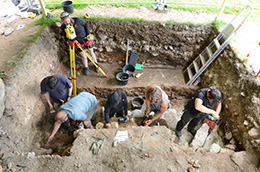
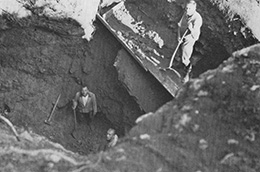
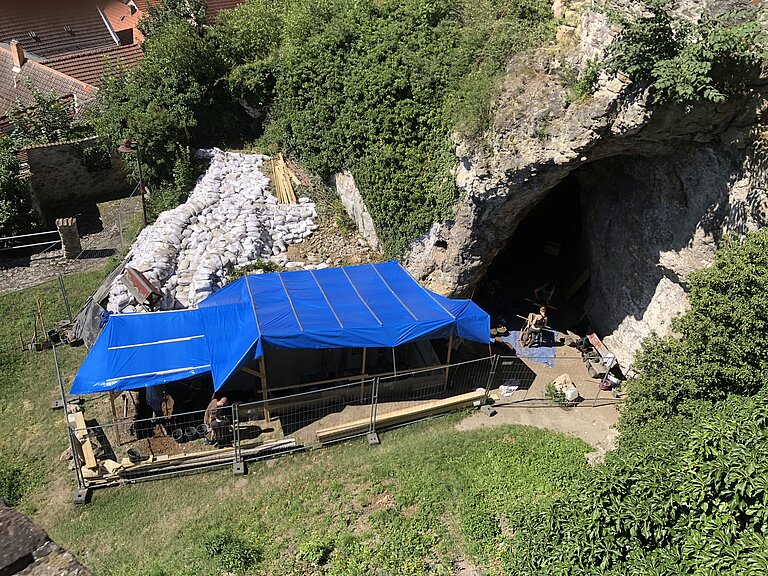
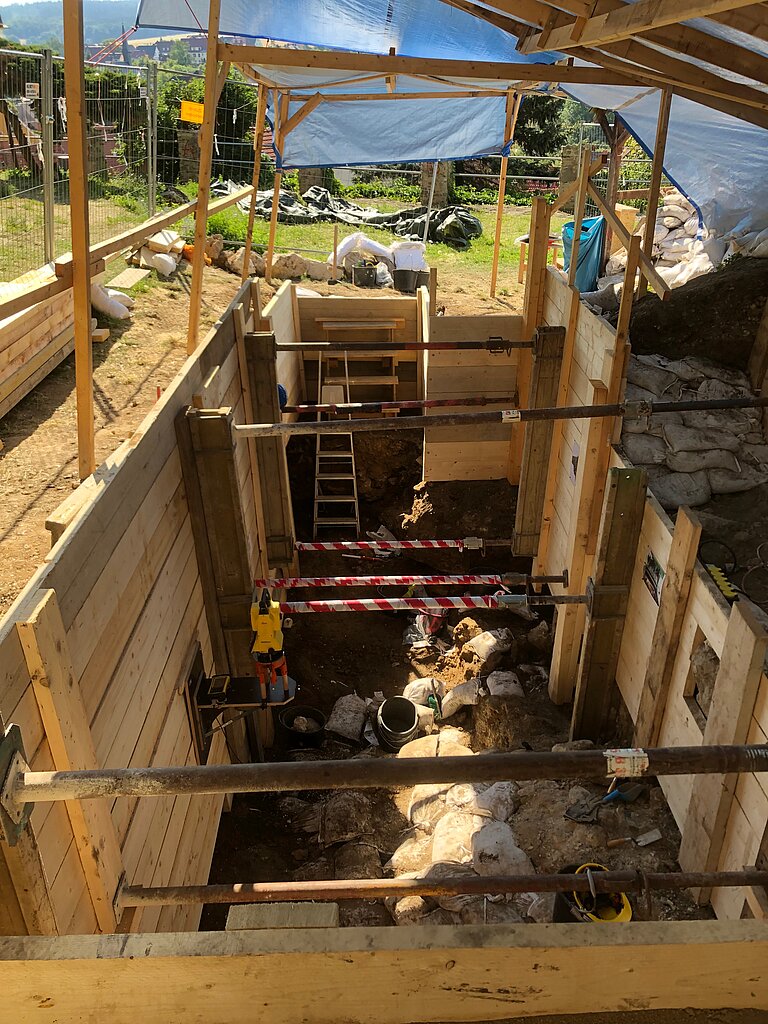
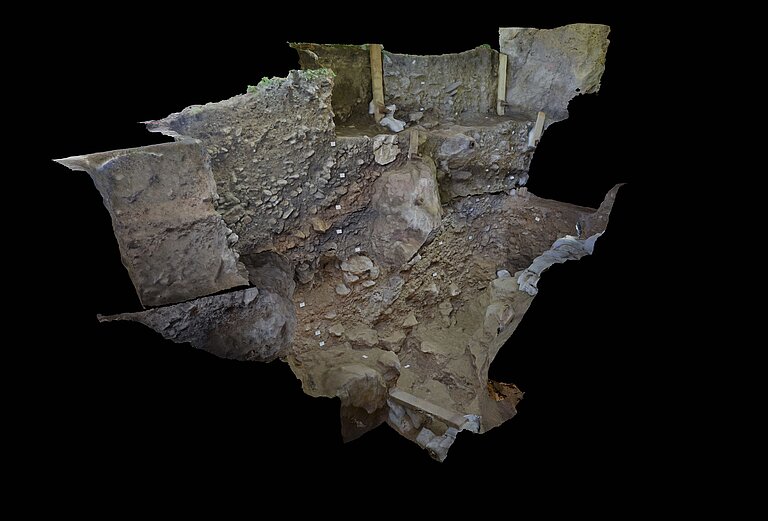
The cave site of Ranis-Ilsenhöhle, Saale-Orla Kreis, Thüringen, is an important data point for the Middle to Upper Paleolithic transition in central Germany and northern Europe. It was excavated between 1932 and 1938 by Werner M. Hülle. The finds from Layer X (Ranis 2) were given the name Ranisian and form one part of the Lincombian-Ranisian-Jerzmanowician (LRJ) transition period complex of northern Europe. Recent studies have shown that bifacial leaf points similar to those from Ranis and Jerzmanowice blade points can be assigned to the final Middle Paleolithic. The stratigraphy of Ranis seems to reinforce the typo-technological arguments for a late, transition period assemblage, as it is probably the only LRJ site in northern Europe where the final Middle Paleolithic is overlain by an early Upper Paleolithic assemblage. However, Ranis, like many key transition period sites, was excavated early in the history of prehistory, and there are reasons to be cautious about interpreting the results.
Because of the importance of the Ranis sequence for understanding the LRJ and the transition from the late Middle Paleolithic to the Upper Paleolithic in central Europe, we reopened and started to excavate Ranis in the summer of 2016 in cooperation with the Landesamt für Denkmalpflege und Archäologie Thüringen, Weimar, Germany. The main goals for this first field season were locating Werner Hülle´s West-East trench in front of the cave, for which a profile drawing is available, and to find in situ sediments representing this profile.
Prior to the fieldwork, in autumn 2015, six resistivity profiles (in each case 48 electrodes with 0.5m distance) were measured to get a better idea of where the previous trenches were located, how deep the deposits are, the presence of boulders, and the configuration of the bedrock. The calculated virtual plans and profiles from this data set provided some insights into the depth of the layers and potential starting points for the new excavation. Additionally, we did percussion core drilling and the material was used to better interpret the resistivity data and to help confirm a distinction between refilling and intact deposits. Here we achieved a depth up to 4.1 m.
During seven weeks of fieldwork in 2016, we managed to achieve our initial goals. We located the West-East trench from 1934 and we found in situ sediments on its southern border. Comparing our profile to the profile drawing of the 1934 excavation, we could identify where in the Ilsenhöhle stratigraphy we are and how much more we have to excavate to reach the LRJ layers. During the subsequent field seasons in 2017 and 2018, we reached the top of the transitional layers. The excavation of these important layers will be the main focus of the coming field seasons.
If you are interested in our project, if you would like to participate in our excavation (July 8th - August 16th), or if you would like to propose a study of the site/materials, please feel free to contact us:
mcpherron@[>>> Please remove the text! <<<]eva.mpg.de
marcel_weiss@[>>> Please remove the text! <<<]eva.mpg.de
hublin@[>>> Please remove the text! <<<]eva.mpg.de
tim.schueler@[>>> Please remove the text! <<<]tlda.thueringen.de
Bacho Kiro (Bulgaria)
One of the more important European Initial UP assemblages in Europe is that of Layer 11 at Bacho Kiro (Bulgaria). This assemblage, which has been called Bachokirian, contains elements of both the Middle and the Upper Paleolithic, though most place it in the latter. The technology is Levallois and retouched points are common, but there are also Upper Paleolithic types and the use of non-local raw materials represents a complete break from the Middle Paleolithic. While some have tried to link Layer 11 to the subsequent Aurignacian, this link is not at all clear, and Layer 11 is probably better compared to other Levallois transitional industries like Boker Tachtit (Layer 1-3) and the Bohunician. It is of key importance to learn who made this industry and to determine its date.
Thus in partnership with the National Institute of Archaeology and with the Museum of the Bulgarian Academy of Sciences, we re-opened the site of Bacho Kiro in 2015 and continue working there now. Our work is focused on two portions of the sequence. First, we are re-excavating a portion of the entire sequence that was protected behind a stone and cement wall. Second, we are also excavating a substantial surface of the critical Layer 11 deposit that was left preserved in a niche a few meters from the main section. In 2016, Layer 11 was exposed in this niche as a very rich deposit of bones and stones. Collagen preservation is extremely good. Initial radiocarbon dates from the top of the complete sequence suggest a date of roughly 32 ka BP, meaning that the approximately 3m section documents the first 10 to 15 ka of the Upper Paleolithic. We expect to continue excavating the site for another two to three years.
If you are interested in our project, if you would like to participate in our excavation, or if you would like to propose a study of the site/materials, please feel free to contact us:
mcpherron@[>>> Please remove the text! <<<]eva.mpg.de
Les Cottés (France)
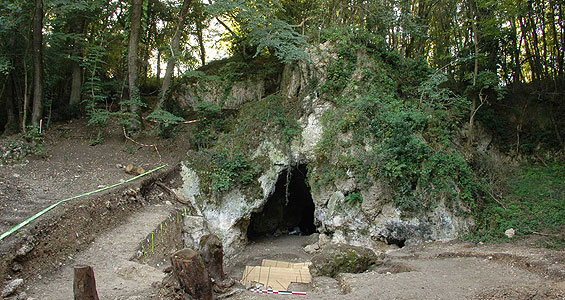
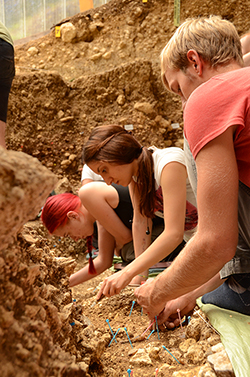
Les Cottés ( Vienne, France) is located on the corridor between the Parisian basin and the Poitou in West-Central France. It is next to the Grand Pressigny area and to the Anglin valley, which are well-known for Paleolithic sites, including the rockart site of Roc-aux-Sorciers in Angle-sur-l’Anglin.
Les Cottés is one of the rare sites, if not the only site, which contains a sequence of Evolved Chatelperronian, proto-Aurignacian and Early Aurignacian. Evolved Chatelperronian is a variant of the Chatelperronian which was first defined at Les Cottés by L. Pradel in the 1950s. It corresponds to a final stage of the Chatelperronian, is characterized by the Les Cottés point, and could therefore be evidence of the final Neandertals’ behavior in France. Proto-Aurignacian and Early Aurignacian with split-base bone points are also well preserved at the site. Anatomically modern human remains were found in the Early Aurignacian layer during the first excavation at the site by R. de Rochebrune in 1881.
Our goal at this site is to better understand the behavior of the last Neandertals and the first anatomically modern humans in Western Europe and to evaluate the nature and the amount of interaction that may have happen between these two populations just before the demise of Neandertals.
A team lead by Marie Soressi started excavating in the summer 2006.
For us, it is a unique opportunity to:
- Document the site formation processes to better understand the archaeological context of the site’s important cultural sequence,
- Document aspects of the Evolved Chatelperronian, proto-Aurignacian and Early Aurignacian behavioral repertoire at a single location,
- Date, using several different methods, the Evolved Chatelperronian, proto-Aurignacian and the Early Aurignacian.
More information can be found here or here, see also:
Jacobs, Z., Li, B., Jankowski, N., & Soressi, M. 2015 Testing of a single grain OSL chronology across the Middle to Upper Palaeolithic transition at Les Cottés (France). Journal of Archaeological Science, 54, 110-122.
Welker, F., Soressi, M., Rendu, W., Hublin, J. J., & Collins, M. 2015 Using ZooMS to identify fragmentary bone from the Late Middle/Early Upper Palaeolithic sequence of Les Cottés, France. Journal of Archaeological Science, 54, 279-286.
Soressi, M., & Roussel, M. 2014 European Middle to Upper Paleolithic Transitional Industries: Châtelperronian. In Encyclopedia of Global Archaeology (pp. 2679-2693). Springer New York.
Talamo, S., Soressi, M., Roussel, M., Richards, M. and J.-J. Hublin (2012) A Radiocarbon chronology for the complete Middle to Upper Palaeolithic transitional sequence of Les Cottés (France). Journal of Archaeological Science. 39(1):175-183. [pdf]
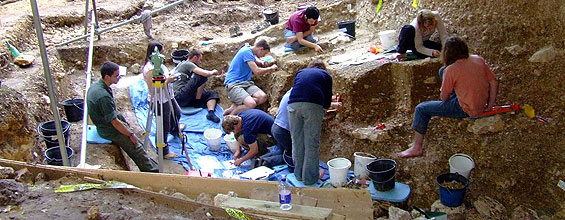
This excavation is funded by
- the Department of Human Evolution
- and the French Ministry of Culture.
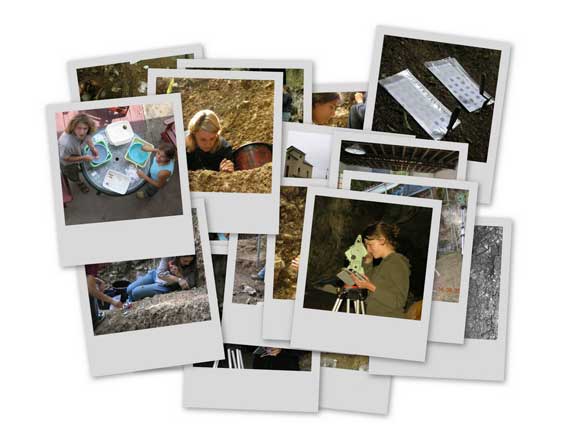
Resava Survey Project (Serbia)
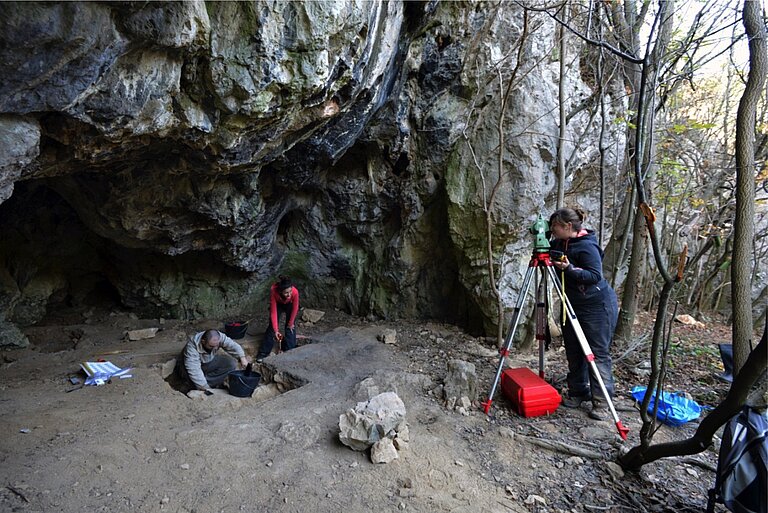
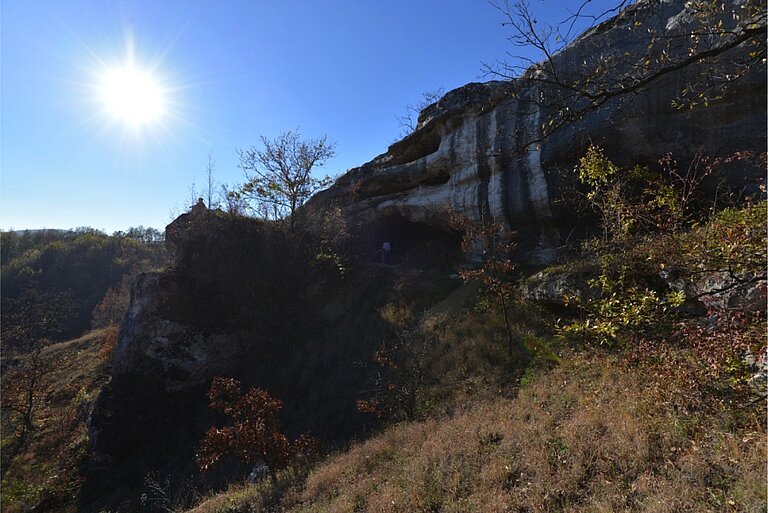
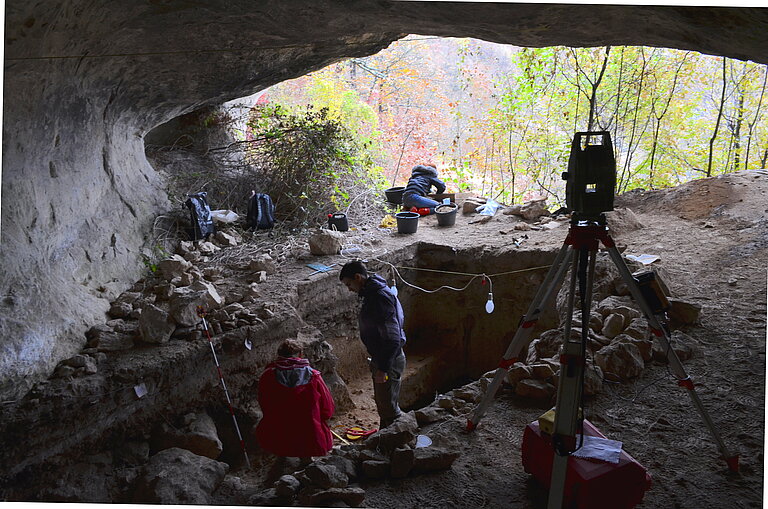
Resava River is located in eastern Serbia, 90 km south of the Danube. In 2012, MPI in collaboration with the Faculty of Philosophy, University of Belgrade, initiated a survey project to detect Pleistocene human occupations in caves and rock-shelters in the limestone rich area of Resava valley. Specific goal was to locate sites that may preserve Late Middle and Early Upper Paleolithic occupation to better understand the context of Neandertal demise and emergence of modern humans in the region. Resava’s proximity to the Danube corridor where many stratified sites with MP and EUP deposits are located indicates its high potential for discovering new sites. Although numerous karstic forms in eastern Serbia have been known for over 100 years, and occasional archaeological prospection carried out 2 decades ago, thus far, no systematic archaeological investigation took place in Resava valley and no Pleistocene deposits with human occupations were evidenced in this area. During our one-year survey, over 40 caves and rock-shelters have been discovered, many of them demonstrating the potential for preservation of Pleistocence deposits. Test excavations of 4 locations in 2013 revealed Upper Paleolithic artifacts in two cave sites: Bukovac and Orlovača. Three season of excavations at these two sites documented successive Middle Paleolithic, Aurignacian, and Gravettian horizons.
Bukovac. At this small cave located just 20 m from the Resava River, Gravettian levels begin from the surface of sediment deposits. One of the two levels attributed to this technocomplex demonstrates high occupation intensity, with remains of hearths, abundant faunal material (bison and ibex prevailing), numerous backed bladelets, and several bone tools. The underlying level, that features lower density of finds, but with traces of hearths, could be assigned to Late Aurignacian. Future work will assess if older deposits are present at this site.
Orlovaca. Underneath Holocene deposits and small assemblage of late Upper Paleolithic, two levels of Aurignacian, Early and possibly Proto, and one Middle Paleolithic horizons are discovered. Low density of finds characterizes this site, though characteristic finds facilitate cultural attribution. Radiocarbon and luminescence dating of these horizons will provide a good opportunity for establishing a chronology of this time period.
The objectives of this project are:
- Obtain new high resolution data to better understand human behavior and adaptations during the MP and UP, primarily based on lithic and faunal assemblages
- Assess formation processes of the deposits
- Establish a reliable chronology using 14C and OSL methods
- Reconstruct climatic and environmental contexts of MP and UP occupations with a specific interest of better understanding the effects of climate on the disappearance of Neandertals and the emergence of modern humans in the region
Past Projects
1. Abri Peyrony (France)
Abri Peyrony (also known as Haut de Combe-Capelle) is a small site at the base of a low cliff face in the Couze valley of southwest France. The site has been excavated twice before: once by D. Peyrony in the 1920s and again by Dibble and Lenoir in 1990. It is best known for its Middle Paleolithic stone tool industries rich in handaxes. Though the site was at the time undated, given its stone tool industries it was thought to date to the end of the Middle Paleolithic and would therefore provide data comparable to what we excavated at Jonzac and at Pech de l’Azé IV. In 2009, along with Michel Lenoir of the University of Bordeaux, we re-opened the site to see if in situ deposits remained. The subsequent excavations over three seasons were part of a program to expand our data set on late Neandertal adaptations in western Europe. 2012 was the last planned excavation season. We are currently analyzing the material and preparing publications.
For more information see
http://www.oldstoneage.com/ap/index.html
2. Jonzac (France)
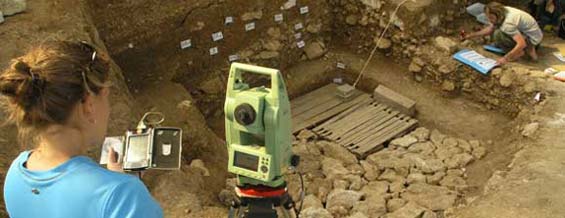
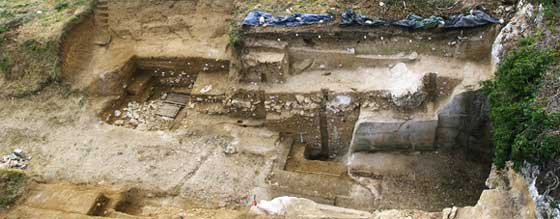
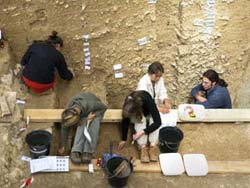
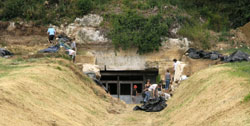
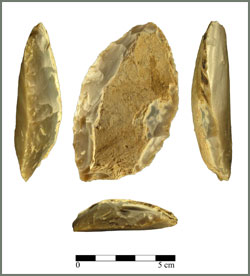

From 2004 through 2007 the MPI, in collaboration with the Institut de Prehistoire et de Geologie du Quaternaire (IPGQ) at the University of Bordeaux I, excavated the Middle and possibly early Upper Paleolithic site of Jonzac (Charente-Maritime), France.
Chez Pinaud Jonzac is today an open-air site situated against a low, limestone cliff in the Seugne River valley. It was first identified in the 1990s by a geologist who observed fauna and stone tools in a section cut through the site by a century old quarry road. Subsequently, excavations were conducted on the exposed sections by Jean Airvaux working under the auspices of the Service de l’archéologie de Poitou-Charente. Airvaux, who excavated for several seasons, sampled the layers exposed in the existing sections and established the depth and extraordinary richness of the deposits.
Airvaux’s excavations, which were published in 2004, show a sequence that begins with a very rich Quina Mousterian industry associated with a fauna dominated by reindeer. These deposits include an over one meter thick layer of densely accumulated fauna followed by several more layers of alternating sterile and archaeological horizons. What follows is more complicated. In one portion of the site a Denticulate Levallois industry is followed by a Mousterian of Acheulian Tradition with numerous bifaces. In another portion of the site, Airvaux identified a Chatelperronian industry. Capping the entire sequence is a dispersed, low density Aurignacian.
With this sequence, given the importance of clarifying the relationship of the late Mousterian, Chatelperronian, and Aurignacian industries to one another and given the significance of this period of time for the transition from Neandertals to anatomically modern humans in western Europe, the MPI and IPGQ team decided to continue work on this site. The goals of this work were as follows:
- Better establish the geological context of the industries. In particular, collect information on site formation processes using evidence from geological, faunal, and lithic observations.
- Obtain dates. Airvaux attempted to date the levels but was unsuccessful. The MPI/IPGQ team has attempted AMS, TL, and OSL dating techniques in order to date this sequence.
- Collect new data on the stone tool industries. The Chatelperronian, in particular, is at present poorly known from the site. The new excavations attempted to clarify the nature of this and the other industries at Jonzac.
- Collect new data from the Quina Mousterian levels. The Quina Mouserian is still a relatively poorly understood phenomenon. At Jonzac, where it is associated with a rich and well preserved fauna, we hope to be able to say something new about this particular Neandertal adaptation.
In the summer of 2007, the MPI/IPGQ team finished four years of excavation at Jonzac aimed at resolving the issues outlined above. Analysis is still on-going but we have also published a number of papers on the results to date. These include:
| 2013 | “Thermoluminescence dates for the Middle Palaeolithic site of Chez-Pinaud Jonzac (France)” Journal of Archaeological Science 40(2):1176-1185 ( D. Richter, J.-J. Hublin, J. Jaubert, S. P. McPherron, M. Soressi, J.-P. Texier). [pdf] |
| 2012 | “Neandertal mobility and large-game hunting: The exploitation of reindeer during the Quina Mousterian at Chez-Pinaud Jonzac (Charente-Maritime, France)” Journal of Human Evolution 63:6242-635. (Laura Niven, Teresa E. Steele, William Rendu, Jean-Baptiste Mallye, Shannon P. McPherron, Marie Soressi, Jacques Jaubert, Jean-Jacques Hublin) [pdf] |
| 2011 | “Strontium isotope evidence for migration in late Pleistocene Rangifer: Implications for Neanderthal hunting strategies at the Middle Palaeolithic site of Jonzac, France” Journal of Human Evolution (Kate Britton, Vaughan Grimes, Laura Niven, Teresa Steele, Shannon McPherron, Marie Soressi, Tegan E Kelly, Jacques Jaubert, Jean-Jacques Hublin, and Michael P Richards) [pdf] |
| 2010 | “Le Gisement Paléolithique de Chez Pinaud à Jonzac (Charente-Maritime)” in (edited by J. Buisson-Catil and Jérôme Primault) Préhistoire entre Vienne et Charente: Hommes et societies du Paléolithique, pp. 117-121. Ministère de la Culture et de la Communication (J. Jaubert, J-J Hublin, S. McPherron, and M. Soressi). |
| 2009 | Identification par l'expérimentation de la percussion au percuteur de calcaire au Paléolithique moyen : le cas du façonnage des racloirs bifaciaux Quina de Chez-Pinaud (Jonzac, Charente-Maritime). Bulletin de la Société Préhistorique Française. 106(2):219-238. (Roussel, M., Bourguignon, L. and M. Soressi) |
| 2009 | Des blocs de calcaire utilisés comme percuteurs dès le Moustérien? L'exemple de Jonzac (Charente-Maritime). In: C. Dumas, B. Roussel and J.P. Texier (eds.), Langage de pierre-La restitution du geste en archéologie préhistorique. Musée des Baux de Provence, 11-13. (Roussel, M., Bourguignon, L. and M. Soressi) |
| 2009 | “An example of Structured-Light Scanning for High-Resolution Documentation of in situ Archaeological Finds” Journal of Archaeological Science 36:19-24. (S. McPherron, T. Gernat, J.-J. Hublin). [pdf] |
| 2008 | "Le statut fonctionnel des bifaces au Paléolithique moyen récent dans le Sud-Ouest de la France. Étude tracéologique intégrée des outillages des sites de La Graulet, La Conne de Bergerac, Combe Brune 2, Fonseigner et Chez-Pinaud / Jonzac" Dissertation, Université Sciences et Technologies - Bordeaux 1, J. Jaubert, dir. (E. Claud) [link] |
| 2008 | “An Application of Structured Light Scanning to Documenting Excavated Surfaces and in situ Finds: Examples from the Middle Paleolithic Sites of Jonzac and Roc de Marsal, France” in Layers of Perception (edited by P. Posluschny, K. Lambers, and Irmela Herzog), Bonn, Dr. Rudolf Habelt, pp. 51-56. (Tim Gernat, Shannon J.P. McPherron, Harold Dibble, and Jean-Jacques Hublin) |
| 2008 | “Isotopic dietary analysis of a Neanderthal and associated fauna from the site of Jonzac (Charente-Maritime), France” Journal of Human Evolution 55:179-185. (M.P. Richards, G. Taylor,T. Steele, S.P. McPherron, M. Soressi, J. Jaubert, J. Orschiedt, J.-B. Mallye, W. Rendu and J.J. Hublin) [pdf] |
| 2008 | “Paléolithique moyen récent et Paléolithique supérieur ancien a Jonzac (Charente-Maritime): premiers résultats des campagnes 2004-2006." In Les Sociétés du Paléolithique dans un Grand Sud-ouest de la France: nouveaux gisements, nouveaux résultats, nouvelles méthodes (edited by J. Jaubert, J.-G. Bordes, and I. Ortega). Mémoire de la Société Préhistorique Française 48:203-244. (J. Jaubert, J-J Hublin, S. P. McPherron, M. Soressi, J-G Bordes, E Claud, D. Cochard, A. Delagnes, J-B Mallye, A. Michel, M. Niclot, L. Niven, S-J Park, W. Rendu, M. Richards, D. Richter, M. Roussel, T.E. Steele, J-P. Texier and C. Thiébaut) |
3. La Ferrassie (France)
The La Ferrassie is a very large rockshelter site in southwest France best known for the discovery of several Neandertal skeletons, as the type site for the Ferrassie Mousterian, and as an important site for the definition of the Aurignacian. La Ferrassie is one of the few sites in southwest France that preserves the Middle to Upper Paleolithic transition when modern humans replaced Neandertals in western Europe. We participated in a project to re-excavate a portion of the western sector of the site from 2010 to 2015. The goals of the project were to shed new light on the context of the Neandertal skeletons and particularly the question of whether they represent burials, to provide ages for the sequence, to reconstruct the paleoenvironmental context of the deposits, and to better understand the stone tool industries which include a Mousterian with bifaces under a Ferrassie Mousterian, a Chatelperronian and an Aurignacian.
For more information see
http://www.oldstoneage.com/lf/index.html
4. Roc de Marsal (France)
Roc de Marsal (Dordogne, France) is a Middle Paleolithic (Mousterian) cave near Les Eyzies. It was excavated by Jean Lafille until his death in 1971. In addition to a rich sequence of stone and bone assemblages, Lafille found the fossilized remains of a Neandertal infant that appeared to have been intentionally buried. The site, like many from this region, was never well published. From 2003 to 2010 we participated in a new excavation project at Roc de Marsal. This project collected new samples in order to better understand its collection, to date the sequence, and to better understand its geological context (in particular the purported burial).
For more information see
http://www.oldstoneage.com/rdm/index.shtm
5. Willendorf (Austria)
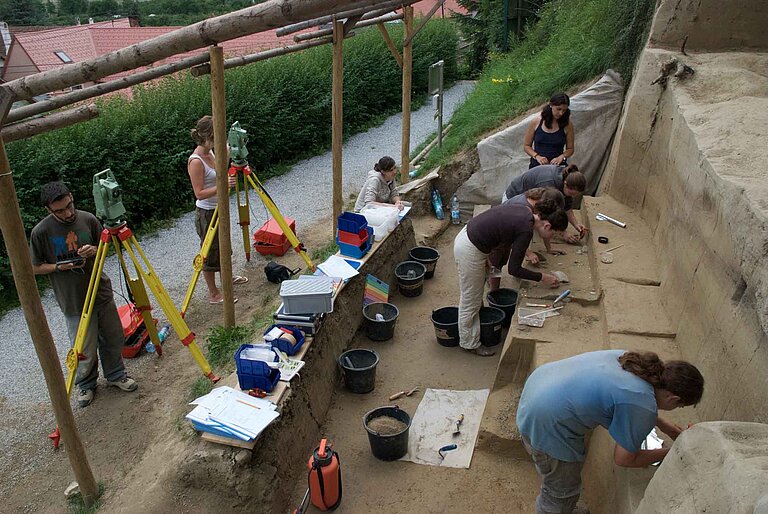
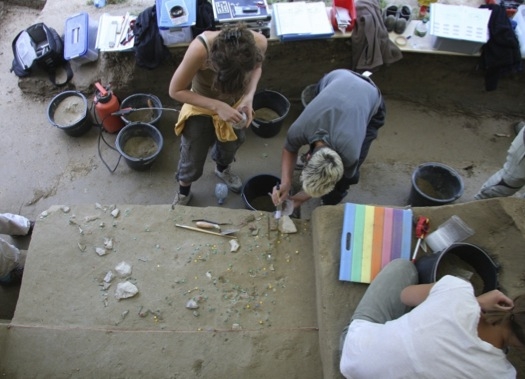
Willendorf II is an open air site in the Austrian Danube valley, approximately 80km west of Vienna (Austria). It is one site out of a cluster of eight sites Willendorf I, Willendorf I-North, Wilendorf II to VII) along the Danube river. The site is famous for the discovery of the famous Venus figurine, but also for the long sequence (nine archaeological horizons).
Willendorf II was discovered in the 19th century and in 1908 the first excavations by the Natural History Museum (Vienna) were started, during which the entire archaeological sequence was exposed for the first time and the Venus figurine was discovered. Additional Fieldwork was conducted between 1909 and 1927. Later, in 1955 the site was re-excavated by the University of Vienna. Geological fieldwork with a focus on stratigraphy, site formation, and the age of the deposits was conducted in 1981 and 1993 by a joint Belgian-Austrian team. Since 2006 the current team has been working at the site.
The site is characterized by a long loess-paleosol sequence covering roughly the time span of 60 to 25 ka BP. One of the interesting aspects of Willendorf II is the rather high palaeoclimatic resolution of the sequence. Nine archaeological horizons are embedded in this sequence and separated by sterile deposits. The archaeological horizons are covering the Early Upper Palaeolithic, Aurignacian, and Gravettian.
In 2006 a team led by Philip R. Nigst, Bence Viola and Gerhard Trnka started excavating at the site. Our research is focused on the Early Upper Palaeolithic deposits. Our goal is to get a better understanding of the behaviour of the first modern humans in Europe and the climatic conditions under which Neandertals were replaced by modern humans.
The objectives of our work are:
- Document and assess the formation of the site’s deposits,
- Date the deposits by using different dating methods (14C, OSL, TL),Improvement and extension (in the lower deposits) of the site’s chronostratigraphic framework,
- Reconstruct the environment and climate to get a better understanding of the climatic conditions under which modern humans dispersed into Europe,
- Characterization of human behaviour by increasing the lithic and faunal samples with new high resolution data.
The excavation is funded by The Leakey Foundation, the Department of Human Evolution (Max Planck Institute for Evolutionary Anthropology), and the University of Vienna.
For any further information or questions please contact either:
Philip R. Nigst: nigst@[>>> Please remove the text! <<<]eva.mpg.de
Bence Viola: bence.viola@[>>> Please remove the text! <<<]eva.mpg.de
6. Lower Danube Survey Project (Romania)
In addition to targeting keys sites for the research foci of the department, we are also interested in expanding the record by locating new sites of interest. With that in mind, we helped initial and participated in the Lower Danube Survey (LoDanS) Paleolithic Project. This international research project conducted survey in eastern Romania to identify the extent of the Paleolithic occupation of the region, with a particular emphasis on colonization events. The project took a multidisciplinary approach which emphasized archaeological survey based on paleogeographic and paleoenvironmental reconstructions and supported by associated geological projects.
For more information, please refer to the project blog
https://lodans.wordpress.com.
Fitzsimmons, K.E., and U. Hambach (2013) "Loess accumulation during the last glacial maximum: Evidence from Urluia, southeastern Romania" Quaternary International doi:10.1016/j.quaint.2013.08.005
Fitzsimmons, K. E., U. Hambach, D. Veres, R. Iovita (2013) "The Campanian Ignimbrite eruption: new data on volcanic ash dispersal and its potential impact on human evolution" PLoS Onedoi:10.1371/journal.pone.0065839.
Iovita, R., A. Dobos, K. E. Fitzsimmons, M. Probst, U. Hambach, M. Robu, M. Vlaicu, and A. Petculescu, (2013) "Geoarchaeological prospection in the loess steppe: preliminary results from the Lower Danube Survey for Paleolithic Sites (LoDanS)". Quaternary Internationaldoi:10.1016/j.quaint.2013.05.018. Link
Iovita, R., K. E. Fitzsimmons, A. Dobos, U. Hambach, A. Hilgers, and A. Zander (2012) "Dealul Guran: evidence of Lower Paleolithic occupation of the southeast European loess steppe." Antiquity 86(334): 973-989. Link
7. Boker Tachtit (Israel)
One of the key transition period sites is the open-air locality of Boker Tachtit in the central Negev of southern Israel. Discovered and originally excavated by Marks and colleagues in the 1970s, the stone tools were described as capturing the transition from a Middle (Layers 1-3) to an Upper Paleolithic (Layer 4) type approach to blank production. Of interest is the presence of Emirian points in Layers 1-3, making Boker Tachtit the best known site for this industry type, and of interest are comparisons between Boker Tachtit and the Bohunician of central Europe, another very early transition period assemblage of unclear origin. While the lithics from Boker Tachtit were exceptionally well studied and published, Marks was not able to provide a convincing chronology for this important sequence.
Thus, in 2013 we participated in a project led by the Max Planck Weizmann Center for Integrative Archaeology and Anthropology to re-open of this site with the main purpose being to date the sequence. In addition to radiocarbon dating the sequence (led by project leader Boaretto of the Weizmann Center), our department sampled the entire sequence for OSL and led the study of the geological context of the OSL samples and of the archaeological horizons. The project was able to obtain new samples from Marks’ Layers 2 and 4. We are currently working on a publication of this work including the new dates.